| Author |
Topic: 8 string resophonic lap steel?? |
Raymond Jones
From:
British Columbia, Canada
|
 Posted 26 Feb 2010 2:52 pm
Posted 26 Feb 2010 2:52 pm |
|
For a while I have been designing an 8 string resophonic lap steel. QUESTION - will a regular cone take the pressure of the extra strings? Someone must have tried this. This is the layout I have been working on. 2" X 1/2" aluminum frame, I will skin it with sheet aluminum. The aluminum gives a ton of sustain.

 |
|
|
 |
Jason Hull
|
 Posted 26 Feb 2010 3:42 pm
Posted 26 Feb 2010 3:42 pm |
|

Last edited by Jason Hull on 4 May 2012 2:32 am; edited 1 time in total |
|
|
 |
AJ Azure
From:
Massachusetts, USA * R.I.P.
|
 Posted 26 Feb 2010 3:42 pm
Posted 26 Feb 2010 3:42 pm |
|
| You should utilize the forum search function and google tons of resophonic 8 strings on the market. |
|
|
 |
Raymond Jones
From:
British Columbia, Canada
|
 Posted 26 Feb 2010 4:01 pm
Posted 26 Feb 2010 4:01 pm |
|
| Thank you - that gives me hope! |
|
|
 |
Billy Gilbert
From:
Texas, USA
|
 Posted 26 Feb 2010 7:07 pm 8 string reso cone??
Posted 26 Feb 2010 7:07 pm 8 string reso cone?? |
|
That looks like a National cover plate. Do you plan to use a spider bridge or a bisquit bridge??? I have converted 5 six stringers to 8 stringers, using home built 8 string square necks, and spider bridges and haven't had any cone problems, tho the tension screw adjustment is very touchy on the last one I converted. I used Quarterman and Beard cones.   |
|
|
 |
Raymond Jones
From:
British Columbia, Canada
|
 Posted 26 Feb 2010 10:05 pm
Posted 26 Feb 2010 10:05 pm |
|
| Billy, the cone I have is for a bisquit bridge. Anything different over a spider as far as strength? |
|
|
 |
Ulric Utsi-Åhlin
From:
Sweden
|
 Posted 27 Feb 2010 1:43 am
Posted 27 Feb 2010 1:43 am |
|
A PROPERLY ADJUSTED reso assembly puts less
preassure on the cone than You might think ; and,
excessive preassure(acute bridge inserts-TP angle)
kills sound as well.McUtsi |
|
|
 |
Billy Gilbert
From:
Texas, USA
|
 Posted 27 Feb 2010 6:43 am reso bridge
Posted 27 Feb 2010 6:43 am reso bridge |
|
I don't really have any experience with a biscuit bridge but I think they are generally used for playing "Spanish" style. I believe the biscuit cones are 9-1/2" in diameter and a Beard or Quarterman cone is 10-9/16" so if you build for one sized cone you can't use the other. I would suggest that you get a Beard cone and spider bridge. They can also supply you with a slotted 8 string nut and bridge inserts. YMMV   |
|
|
 |
Raymond Jones
From:
British Columbia, Canada
|
 Posted 27 Feb 2010 12:49 pm
Posted 27 Feb 2010 12:49 pm |
|
| yes- the cone I have is 91/2". Didn't know about the diameter difference - very interesting. Tonal difference? Being 100% aluminum could create a unique sound. Should I build a wood or aluminum base for the cone? Wood would isolate metal on metal, perhaps dull the total "tin can" sound. |
|
|
 |
Billy Gilbert
From:
Texas, USA
|
 Posted 27 Feb 2010 1:02 pm reso cone, etc.
Posted 27 Feb 2010 1:02 pm reso cone, etc. |
|
| Several years ago I put together a reso with a brass body and wooden neck. I put a regular plywood sound well in it, and it sounded very much like a wood bodied instrument. It was very heavy and not at all suitable for playing standing, with it hanging from a strap. Yours may be heavy too, as your side material looks pretty thick. You might consider putting legs on it. I don't think what you use on the top and bottom will change the tone very much. The cone is what makes the sound. That biscuit cone won't sound like a spider bridge cone. YMMV |
|
|
 |
Raymond Jones
From:
British Columbia, Canada
|
 Posted 28 Feb 2010 2:15 pm
Posted 28 Feb 2010 2:15 pm |
|
| From a simple thought and love of building to? All your info is great and much appreciated! I just spent a lot of time listening to samplers from "Folk of the Wood" - everything one does, in construction and materials, makes a tonal difference to the finished outcome of your guitar. It seems like gather all the info you can and just build it and see. The old - "nothing ventured nothing gained". |
|
|
 |
Alan Brookes
From:
Brummy living in Southern California
|
 Posted 28 Feb 2010 6:49 pm
Posted 28 Feb 2010 6:49 pm |
|
Many people have built 8 and 12-string resonators. The cones WILL take the weight of the strings. Check out this conversion that I did a few years ago...
http://bb.steelguitarforum.com/viewtopic.php?t=117146&highlight=conversion
| basilh wrote: |
Alan why don't you post the conversion process pictures ?
It was most informative. |
Okay Basil, here we go.....
TAKE ONE EIGHT=STRING FRETLESS ACOUSTIC GUITAR
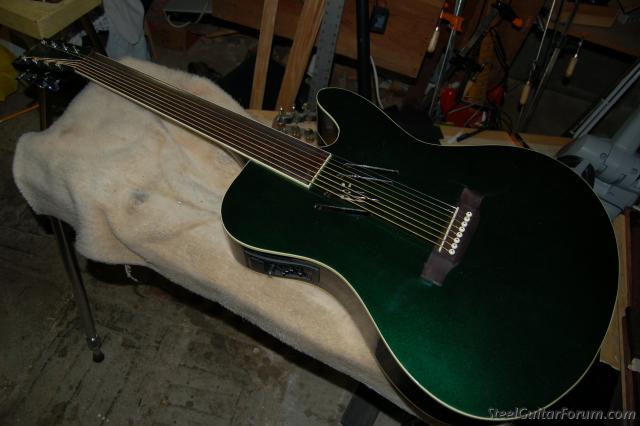
CUT A BLOODY GREAT HOLE IN IT...
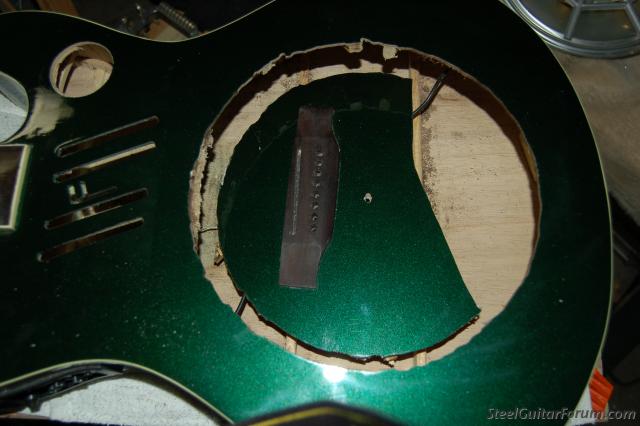
I used a hand router with a circle cutting attachment, after first drilling a guide hole.
Notice that this cuts through the bracing and compromises the strength of the top.
Carefully remove the sensor for the piezzo pickup. Make sure during all that cutting you don't cut through the wiring or you're going to have to mend it. (Not the end of the world.)
CUT TWO SMALLER HOLES.
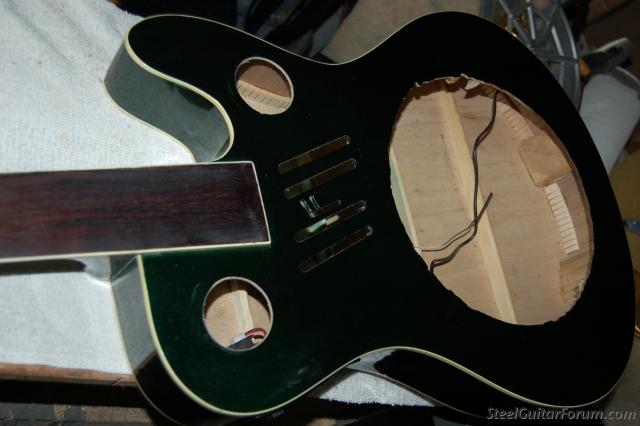
This time a circle cutter can be used, but remember to clamp two small pieces of wood behind the table, or the circle cutter will tear away the back of the wood.
Now we have to think of reinforcing the top. Here's what we have so far. Notice the sensor hanging loose.
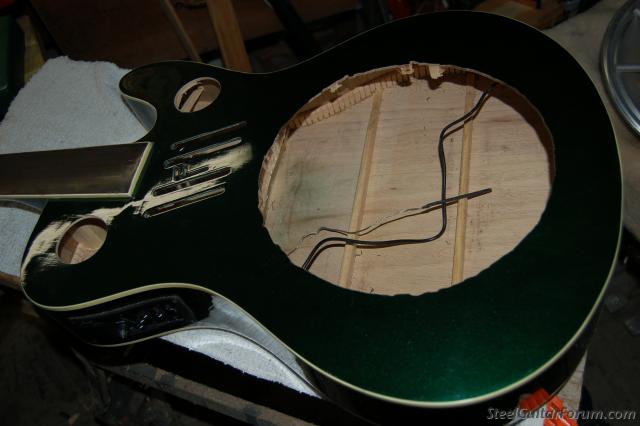
GLUE IN ADDITIONAL SUPPORTS FOR THE TOP.
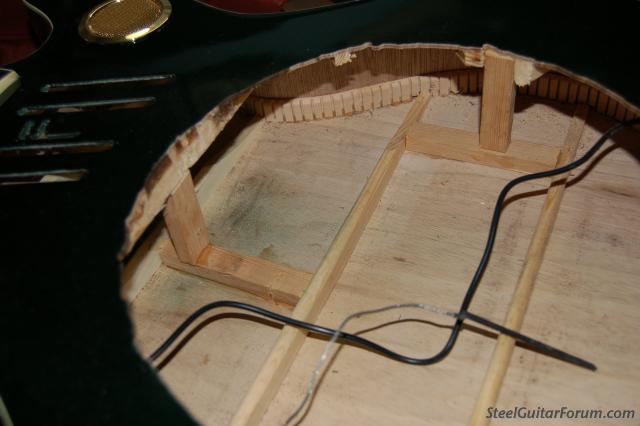
You can also glue in the small hole covers.
MASK THE FINGERBOARD. CALCULATE THE FRET POSITIONS USING AN EXCEL SPREADSHEET. MARK THE FRETS ON THE FINGERBOARD.
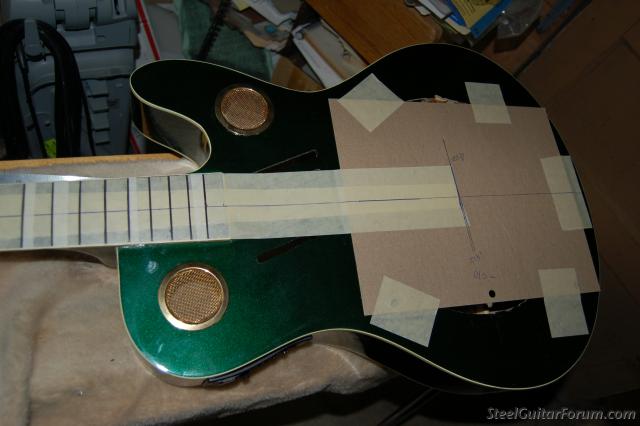
Note that in order to calculate the fret positions it is useful to cover the hole with cardboard and mark on the position of the bridge and the center line. Calculate the fret positions in MILLIMETRES, However much you might like to work in inches the calculation will give fractions of an inch, and very few rulers are marked off in hundreths of an inch !
CUT THE FRET POSITIONS WITH AN XACTO KNIFE. (TWO CUTS PER FRET.) REMOVE THE STRIPS OF MASKING TAPE WHERE THE FRETS ARE. PAINT OVER THE GAPS WITH GOLD PAINT, (which matches the resonator... use any color you want.)

REMOVE THE MASKING TAPE. CHANGE THE TUNERS FOR GIBSON-TYPE WHICH MATCH THE RESONATOR.
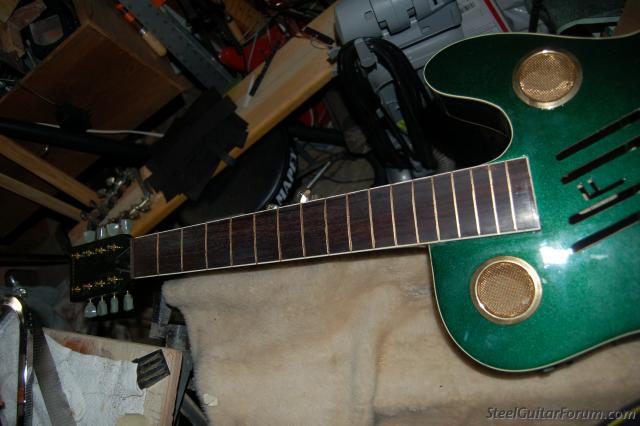
BUILD A NUT
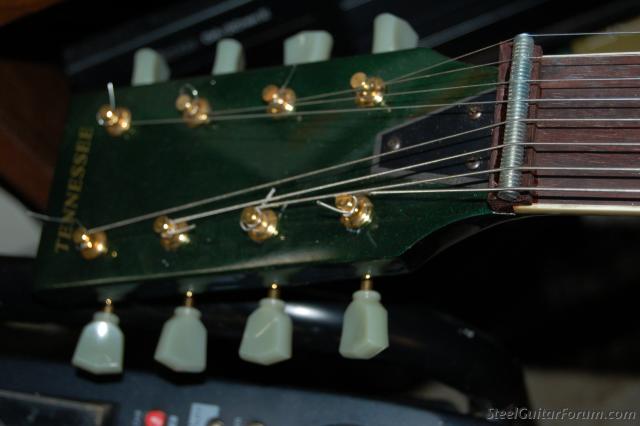
The base is carved ebony. I like to use threaded steel rod for the nut. This allows you to change the string spacing any time you want, and it keeps the strings in position securely.
SCREW DOWN THE RESONATOR PLATE AND CONE.

Notice the additional two holes cut into the tailpiece. I've seen people put eight strings into six holes but it's not very secure. Eight-string tailpieces are available if you want to spend more money.
What you can't see here is the bridge. The spider has a slot. I rounded out this slot with a file to the same diameter as the tapped rod, and used the same tap rod as on the nut, remembering to leave a space at the centre so that the cone can be adjusted if necessary. In other words the bridge is two short pieces of rod, glued in with impact adhesive.
It is not commonly known, but the piezzo pickup sensor does not have to be underneath the bridge. I glued it direct to the spider, just in front of the bridge.
AND THERE WE HAVE IT... AN EIGHT-STRING ACOUSTIC/ELECTRIC RESONATOR GUITAR.
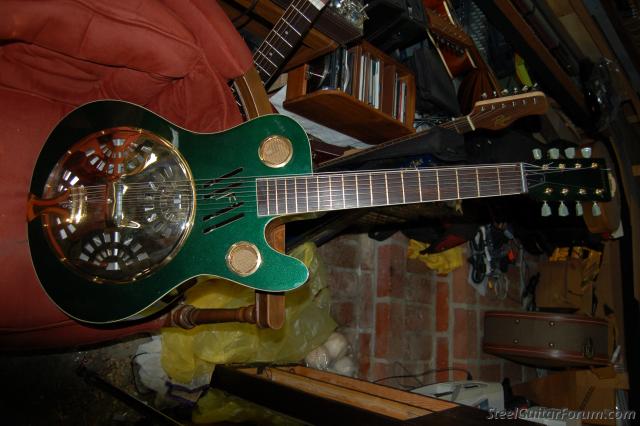
It sounds great and the electrics work great too.  |
|
|
 |
Mark Roeder
From:
Milwaukee, Wisconsin, USA
|
 Posted 1 Mar 2010 7:18 am
Posted 1 Mar 2010 7:18 am |
|
Looks like a fun project. I noticed Alan likes to use threaded rod for the nut. Another idea is to put unthreaded rod (aluminum or ss) in a drillpress and while it is spinning press a V shaped file to it to cut the string notch. A caliper is good to measure depth. Mark the spacing first.
_________________
www.deluxe34.com lap steel stands, Clinesmith, Gibson Console Grande, Northwesterns, The Best Westerns
https://www.facebook.com/TheBestWesterns |
|
|
 |
Roger Shackelton
From:
MINNESOTA (deceased)
|
 Posted 1 Mar 2010 4:39 pm
Posted 1 Mar 2010 4:39 pm |
|
Does anyone have an 8 string TRI-CONE guitar?
ROGER |
|
|
 |
chris ivey
From:
california (deceased)
|
 Posted 1 Mar 2010 5:56 pm
Posted 1 Mar 2010 5:56 pm |
|
| very cool alan...and you didn't even have to refinish anything. neat! |
|
|
 |
Brad Bechtel
From:
San Francisco, CA
|
|
|
 |
Stephan Miller
From:
Silver Spring, Maryland, USA
|
 Posted 2 Mar 2010 1:00 pm
Posted 2 Mar 2010 1:00 pm |
|
Thanks for the link to Ellis Guitars. Cool (and very pricey) instruments. Wouldn't mind owning one of those percussion stompboxes! Their 8-string tricone has a longer (baritone) scale neck, and I'd look at it as more of a 7-stringer, since strings 1 & 2 are double-coursed and tuned the same, like the the 1st pair on a standard 12-string guitar. The only Forumite I know who owns an 8-string tricone is Howard R, who has posted about it-- a custom-made National.
I think even 7-string tricones are pretty rare-- I got one from Harry Sheppard (Harbor Lights electric steels)-- it started life as a Johnson style 4, which he upgraded with National and Beard parts, did the "mushroom mod", then converted to 7 strings. I have it in A6. Harry did a terrific job on it. |
|
|
 |
Curt Langston
|
 Posted 2 Mar 2010 3:45 pm
Posted 2 Mar 2010 3:45 pm |
|
Good job!
Don't ask too much advice, as you'll only get misguided opinions!
Go for it!
Looks great, and it will sound great!
 |
|
|
 |




